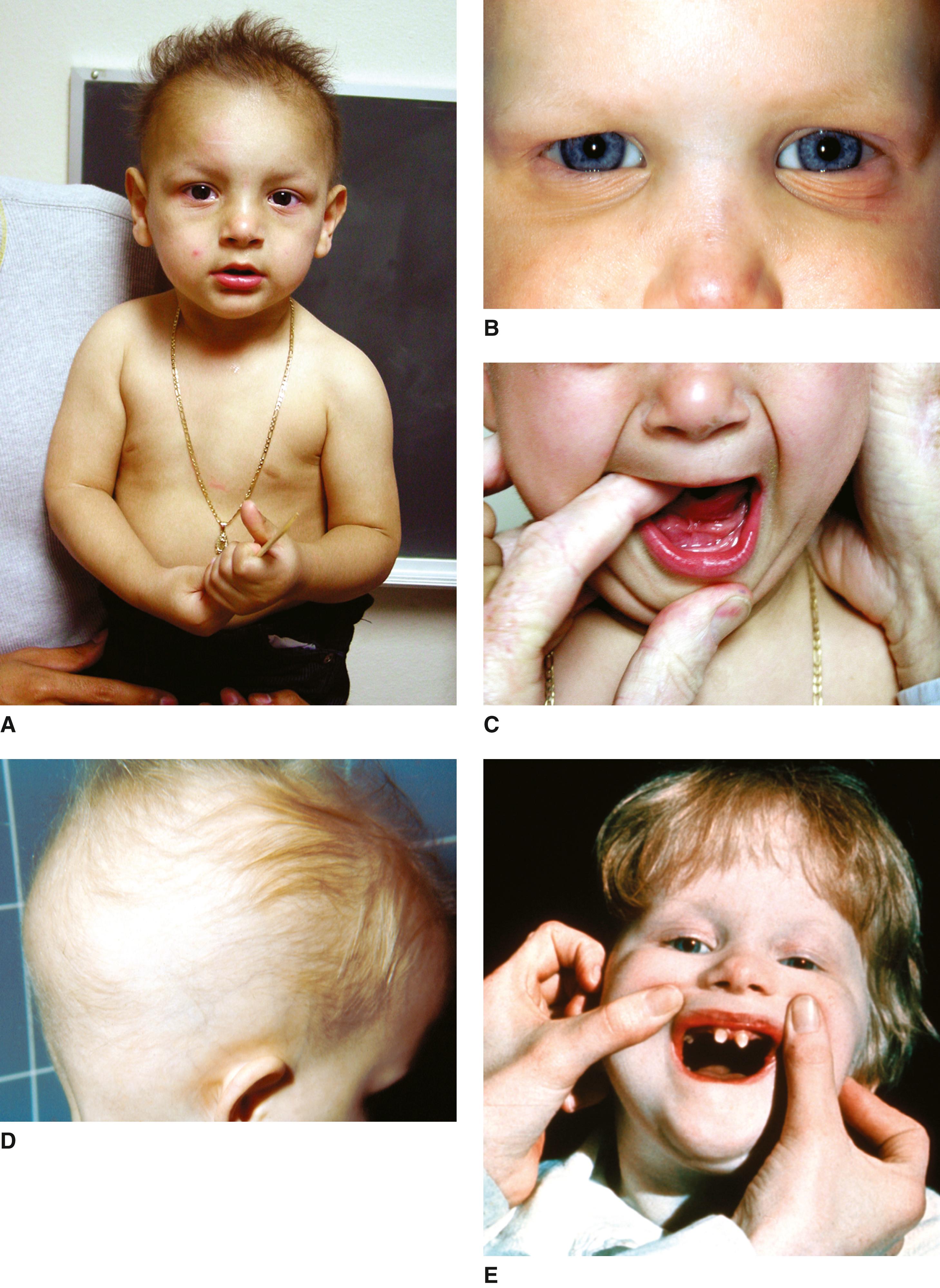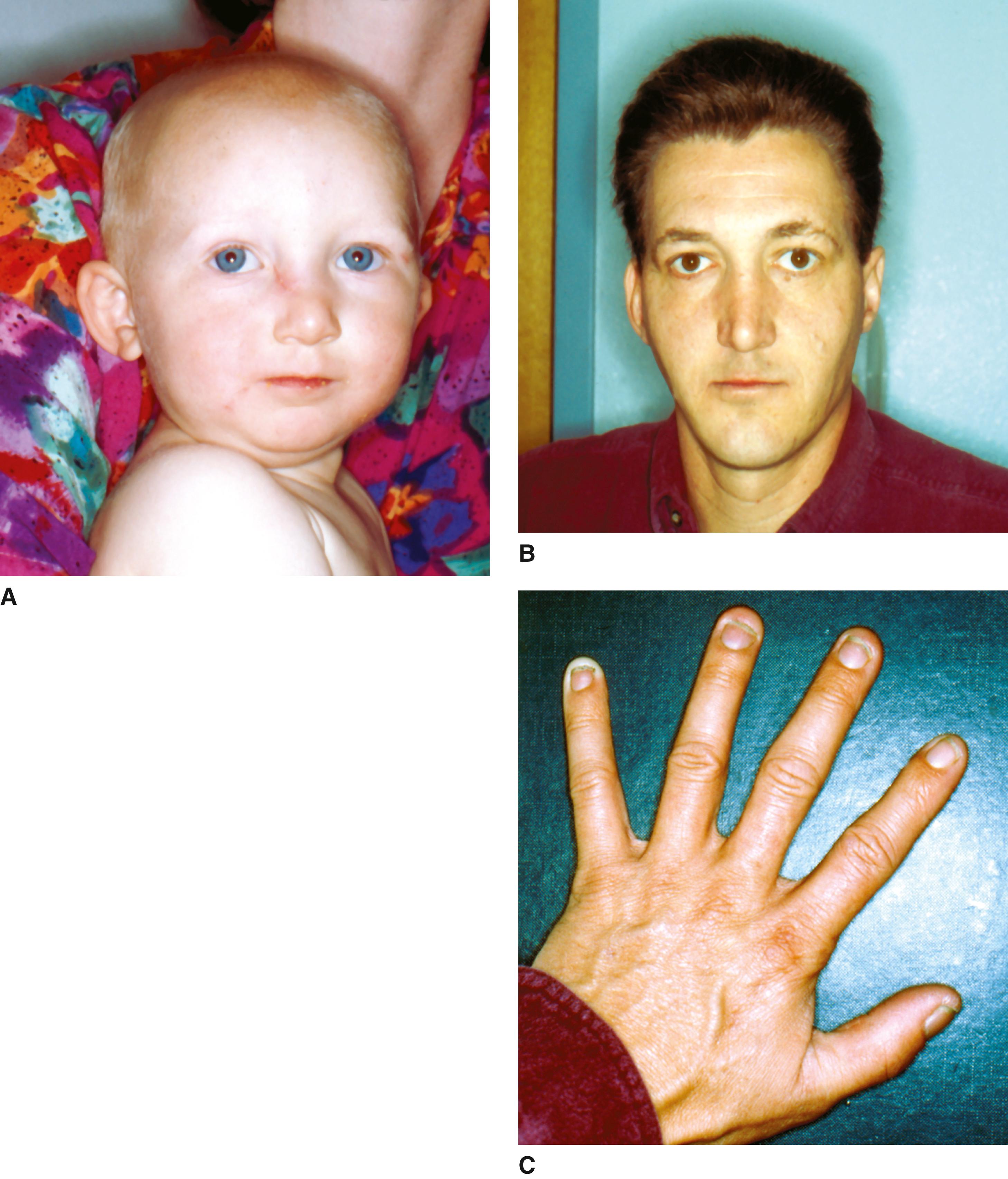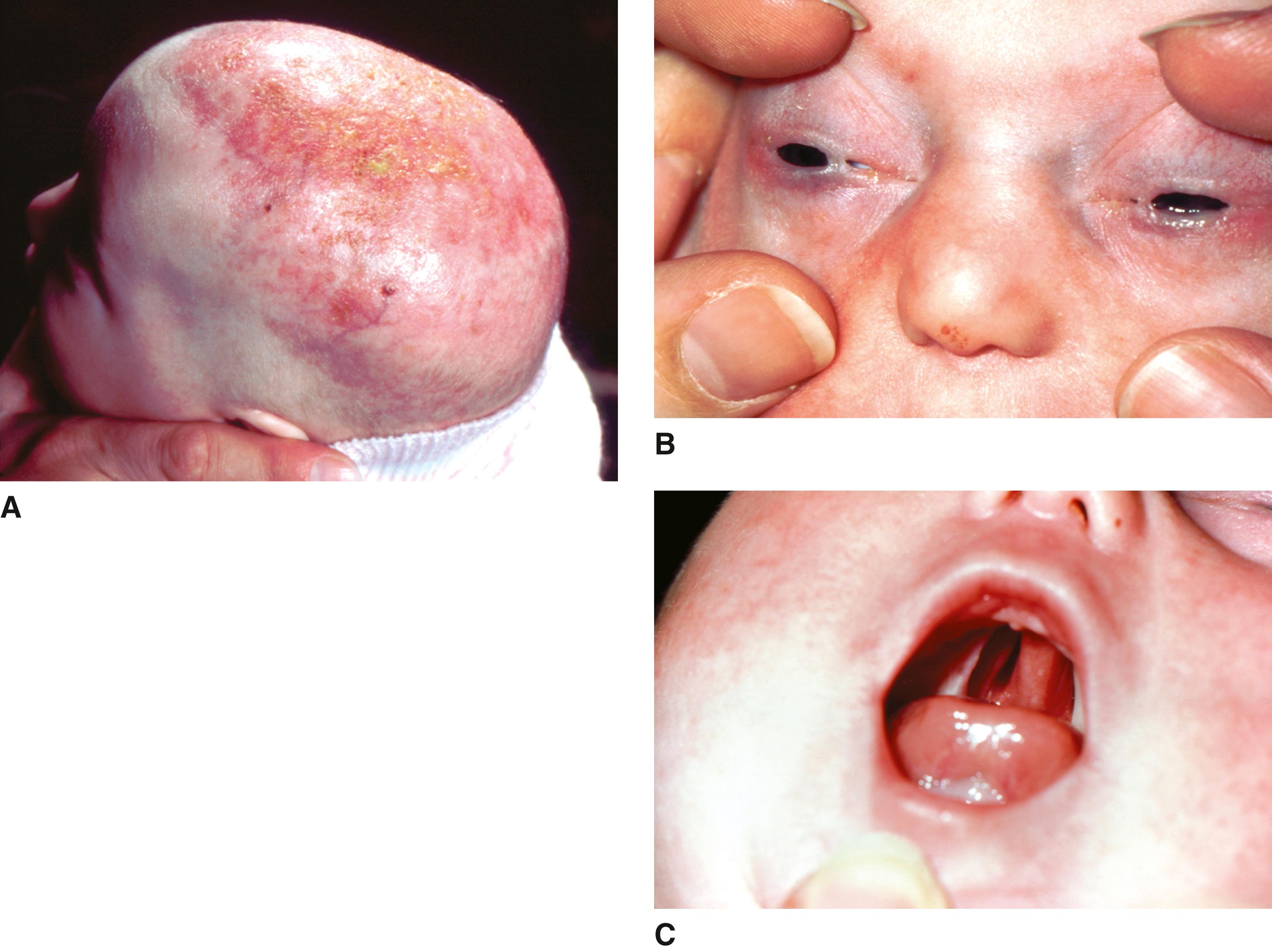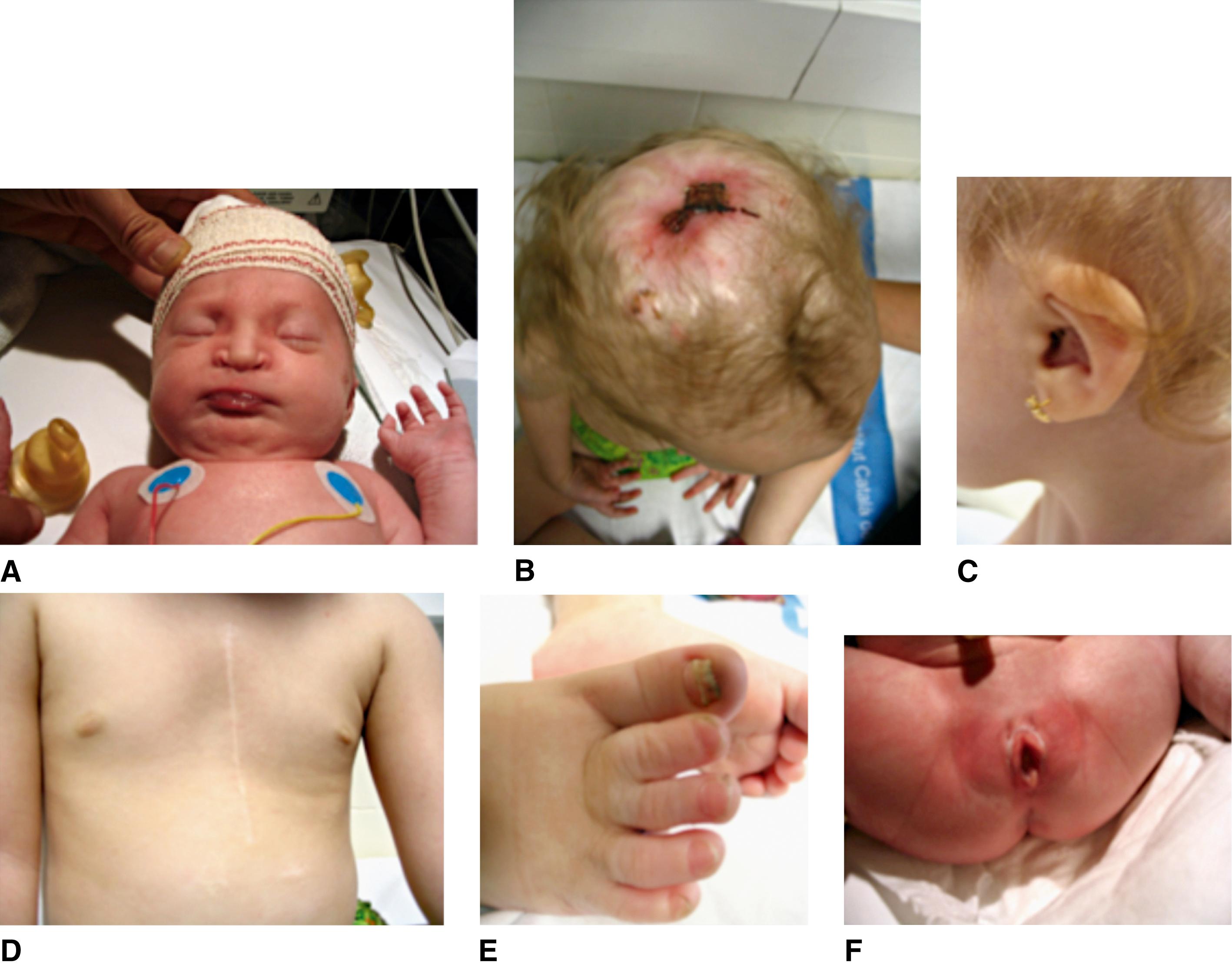Physical Address
304 North Cardinal St.
Dorchester Center, MA 02124
There are a number of ectodermal dysplasia (ED) syndromes, only a few of which are represented in this text. The division into hypohidrotic ectodermal dysplasia (HED) and hidrotic categories based on the extent of the deficit of sweat glands is in no way absolute. Just as there is variable hypoplasia of hair follicles, there is variable hypoplasia of sweat glands.
Thurman described this entity in 1848. In 1875, Charles Darwin set forth the following concise commentary about this disease: “I may give an analogous case, communicated to me by Mr. W. Wedderhorn of a Hindoo family in Scinde, in which ten men, in the course of four generations, were furnished, in both jaws taken together, with only four small and weak incisor teeth and with eight posterior molars. The men thus affected have very little hair on the body, and became bald early in life. They also suffer much during hot weather from excessive dryness of the skin. It is remarkable that no instance has occurred of a daughter being thus affected.” This is the description of the classic form of HED. Milder forms will not carry significant risk due to less decreased sweating.
Skin. Thin and hypoplastic, with decreased pigment and a tendency toward papular changes on face; periorbital wrinkling and hyperpigmentation; scaling or peeling of skin in immediate newborn period. Plantar hyperkeratosis.
Skin Appendages. Hair: fine, dry, and hypochromic; pili torti; sparse to absent scalp and body hair, secondary sexual hair near normal; sweat glands: hypoplasia to absence of eccrine glands; apocrine glands more normally represented; hypoplasia to absence of sebaceous glands; lack of dermal ridges.
Mucous Membranes. Hypoplasia, with absence of mucous glands in oral, aural, and nasal membranes; mucous glands may also be absent from bronchial mucosa. Nasal and aural concretions, swallowing difficulties. Dry eyes owing to Meibomian glans hypoplasia.
Dentition. Hypodontia to anodontia, with an average of nine permanent teeth, most commonly canines and first molars, resulting in deficient alveolar ridge; anterior teeth tend to be conical in shape. Delayed eruption of teeth. Retruded appearance of the midface.
Craniofacial. Low nasal bridge, small nose with hypoplastic alae nasi, full forehead, prominent supraorbital ridges, midface hypoplasia, relative prognathism, prominent lips.
Hoarse voice, hypoplasia to absence of mammary glands or nipples, deficient milk production during nursing, absence of tears, failure to develop nasal turbinates, mild-to-moderate nail dystrophy, eczematous change in skin, asthmatic symptoms.
Neonates with hypohidrotic ectodermal dysplasia may be diagnosed because of peeling skin, similar to that of “postmature” babies, and periorbital hyperpigmentation. In infancy irritability may occur because of heat intolerance. Hyperthermia as a consequence of inadequate sweating not only is a serious threat to life but may be the cause of intellectual disability, which is an occasional feature of this disorder. Living in a cool climate and cooling by water when overheated are important measures. The hypoplasia of mucous membranes plus thin nares may require a humidified environment and frequent irrigation of the nares to limit the severity of mucous clots and purulent rhinitis. External otitis and otitis media and lung infection may also be consequences of the mucous membrane defect. Mucous glands are hypoplastic to absent, not only in the respiratory tract, but in esophageal and colonic mucosa as well. Although the patient is often hairless at birth, some hair may develop. Short stature is not considered a feature of this disorder. Therefore, affected males with growth deficiency should be evaluated for other causes of short stature, such as endocrine deficiencies.
The classic form of HED has, in 70% of cases, an X-linked recessive inheritance pattern. The gene ( EDA ) has been localized within the region Xq12-q13.1. It encodes a protein, ectodysplasin, which is important for normal development of ectodermal appendages. Deletions and duplications have been reported in 10% of cases, and still 10% of cases with the X-linked form do not have mutations or deletions identified in these genes. It has been estimated that 60% to 80% of female carriers can be identified by dental examination showing conic teeth. Sweat testing, coating the skin with an iodine solution that changes color with sweat, and raising temperature to induce sweating can identify a mosaic sweat pattern in greater than 90% of carrier females. Mutations in the ectodysplasin anhidrotic receptor ( EDAR ) gene located at 2q11-q13 (10% to 15%), as well as mutations in the ectodysplasin anhidrotic receptor–associated death domain ( EDARADD ) gene located at 1q42.2-q43 (1% to 2%), and loss-of-function and missense heterozygous mutations in the WNT10A gene, located on chromosome 2q35 (5-6%), are responsible for the autosomal dominant “mild” forms of HED, where as biallelic mutations of these three genes cause the recessive “classic” forms of HED. Nuclear factor kappa B (NF-κB) signaling responsible for ectodermal development is altered as a consequence of mutation in all those genes.
Loss-of-function and missense biallelic mutations in the WNT10A gene have been reported to cause Schopf-Schulz-Passarge syndrome (keratosis palmoplantaris with cystic eyelids, hypodontia, and hypotrichosis) and the odonto-onycho-dermal dysplasia, a rare form of severe ectodermal dysplasia. The phenotype may not be distinguished from classic HED, except for generalized microdontia. Heterozygous mutations can cause isolated hypodontia. Finger and toenails may be absent in cases with mutation of WNT10A .

(Ankyloblepharon-ectodermal defects-cleft lip/palate syndrome (AEC syndrome) aka Hay Wells syndrome, also including Rapp-Hodgkin syndrome.)
Rapp and Hodgkin reported three affected individuals in 1968 with a new form of ectodermal dysplasia. In 1976, Hay and Wells described a specific type of ectodermal dysplasia associated with cleft lip or cleft palate and congenital filiform fusion of the eyelids. The variable phenotype of the Tumor protein p63 gene (TP63) - associated ectodermal dysplasia includes combinations of ectodermal dysplasia, cleft lip/palate, split-hand/foot malformation/syndactyly, lacrimal duct obstruction, hypopigmentation, and hypoplastic breasts and/or nipples.
Craniofacial. Oval face; high forehead, absence of lacrimal puncta; ocular hypotelorism; ankyloblepharon filiforme adnatum; broadened nasal bridge; maxillary hypoplasia; micrognathia; thin vermillion border; cleft lip, cleft palate, or both; short philtrum; hypoplastic alae nasi; small, sometimes cup-shaped, ears. Freckling.
Mouth and dentition. Small mouth, cleft lip with or without cleft palate, cleft palate alone, cleft uvula, velo–pharyngeal incompetence, trismus; conical, widely spaced teeth; hypodontia to partial anodontia, mean of permanent teeth is five.
Skin. Palmar and plantar keratoderma with skin erosions; peeling erythematous, eroded skin at birth from limited to high percentage of body surface area; hyperkeratosis; patchy, partial deficiency of sweat glands; partial anhidrosis; scarring and reticulated hyperpigmentation on the neck and intertriginous areas.
Hair. Wiry and sparse to alopecia; head and/or eyelashes both affected; hypoplasia of lateral one-third of eyebrows. Pili canaliculi.
Nails. Small. Characteristic nail dystrophy with small, thick, hyperconvex nails or anonychia.
Hands and Feet. Syndactyly of the second and third toes and of the third and fourth toes; syndactyly of the third and fourth fingers; internal toe deviation; broad first toe.
Genitalia : Hypospadias in most males.
Short stature, ptosis, atretic ear canals, hearing loss, absent lingual frenulum and sublingual caruncles, glossy tongue, hypothelia, supernumerary nipples; in rare cases, ventricular septal defect or patent ductus arteriosus; micropenis, labial anomalies, vaginal dryness or erosions; split hand/split foot; camptodactyly; hypoplasia of toes; Wilms tumor.
Surgical excision of the ankyloblepharon filiforme adnatum is required during the early neonatal period. However, photophobia is common. Surgical closure of facial clefting and early ophthalmologic evaluation of the lacrimal duct system are required. Hyperthermia occurs, in rare cases, in early childhood. Thereafter, although reduced sweating is described subjectively, heat intolerance is not usually a problem, and sweat studies may be normal. Superficial skin erosions vary from limited to severe full-body involvement. The erosions most typically affect the scalp at birth and during infancy. Severe scalp erosions often lead to scarring alopecia and hypotrichosis. Severe chronic granulomas of the scalp, which begin as infections, have been a serious problem. Otitis media occurs frequently.
Whereas the clefting seen in most genetic syndromes is consistent (i.e., either cleft lip with or without cleft palate [CLP] or cleft palate alone [CPA]), mixed clefting (the occurrence of CLP and CPA in the same family) occurs in this disorder. Deficient mucous coating of vocal cords can affect vocal quality. Speech and feeding may be affected.
This disorder has an autosomal dominant inheritance pattern. Mutations of the TP63 gene located on 3q27 are responsible. More than 80% of documented mutations are found in the sterile alpha motif domain, with the remaining 20% occurring in. ΔNp63-specific N-terminal domain. Targeted studies of exons 13 and 14 can be done prior to whole gene sequencing.
Hay-Wells (AEC) syndrome and Rapp-Hodgkin syndrome are now thought to be the same condition with variable presence of ankyloblepharon. Mutations of the p63 gene have been identified in other phenotypes, including ectrodactyly–ectodermal dysplasia–clefting syndrome (EEC syndrome) type 3, dermato-ungual-lacrimal-tooth syndrome (ADULT syndrome), limb-mammary syndrome (LMS), and nonsyndromic split-hand/foot syndrome (SHFM) type 4, and isolated cleft lip and palate. Allelic heterogeneity for the same condi tion and marked clinical inter- and intrafamilial variability for single mutations are the rule within the wide spectrum of TP63 -associated disorders. Prenatal mutations testing should be accompanied by detailed ultrasound imaging for the presence of major defects such as ectrodactyly or clefting.


In 1978, Finlay and Marks reported 10 affected members of a family with defects of the scalp, ears, and nipples inherited as an autosomal dominant trait. It still appears to be a very rare disorder with fewer than 50 cases reported. Also called scalp-ear-nipple (SEN) syndrome, the abnormally shaped ears and the scalp defect appear to be almost constant features, and the nipple abnormalities are present in more than 50% of cases.
Craniofacial. Aplasia cutis congenita of scalp; prominent and abnormally shaped ears with hypoplastic tragus, antitragus, and lobule, overfolding of the superior helix, and flattening of the antihelix; telecanthus; broad nasal bridge with excess skin over the glabella; bulbous nasal tip; short columella.
Skin. Rudimentary or absent nipples in both males and females. Mild hypohidrosis with reduced apocrine sweat glands; scanty hair, eyelashes, and eyebrows; reduced pubic and axillary hair.
Nails. Brittle, dysplastic nails.
Dentition. Irregular dental eruption and tooth size, widely spaced upper central incisors, irregular alveolar ridges in the newborn.
Extremities. Partial cutaneous syndactyly of third and fourth fingers and second and third toes, camptodactyly of the fifth fingers.
Renal and Urinary Tract. Renal agenesis or hypoplasia, vesicoureteral reflux, pyeloureteral duplication; secondary renal insufficiency and hypertension.
Congenital heart defects, rhombencephalosynapsis, coloboma of the lower eyelids and/or iris, congenital cataract, Stahl deformity of the ear, prominent crus of the helix, natal teeth, absence of ear wax, hypospadias, diabetes mellitus, obesity, hair loss, hypertension, loss of libido.
The area of aplasia cutis congenita heals over the first year with a lumpy surface consisting of bundles of connective tissue. The scalp hair is sparse in that area. Hypoplastic nipples are common. In some cases the breasts have not enlarged during pregnancy, nor has lactation occurred. The excess skin in the glabellar region has been excised and seen to be lipomatous. The frequency of urinary defects warrants investigation and follow up in order to prevent renal failure. Some cases suggest hypertension may also be a primary feature. Diabetes at an early age has been reported in only one family.
Autosomal dominant inheritance. Both sporadic and familial cases with vertical transmission have been reported, as well as recurrence presumably owing to germline mosaicism. Potassium-channel tetramerization-domain-containing 1 ( KCTD1 ) mutations were found in a total of ten families affected by SEN syndrome. KCTD1 inhibits the transactivation of the transcription factor AP-2α (TFAP2A), and mutations in TFAP2A cause cutis aplasia in individuals with branchio-oculo-facial syndrome (BOFS).
The phenotypic features of SEN syndrome overlap with those of several syndromes, perhaps most notably ulnar-mammary syndrome and ectrodactyly with ectodermal dysplasia and cleft lip/palate syndrome (EEC), but also other ectodermal dysplasias.

Become a Clinical Tree membership for Full access and enjoy Unlimited articles
If you are a member. Log in here